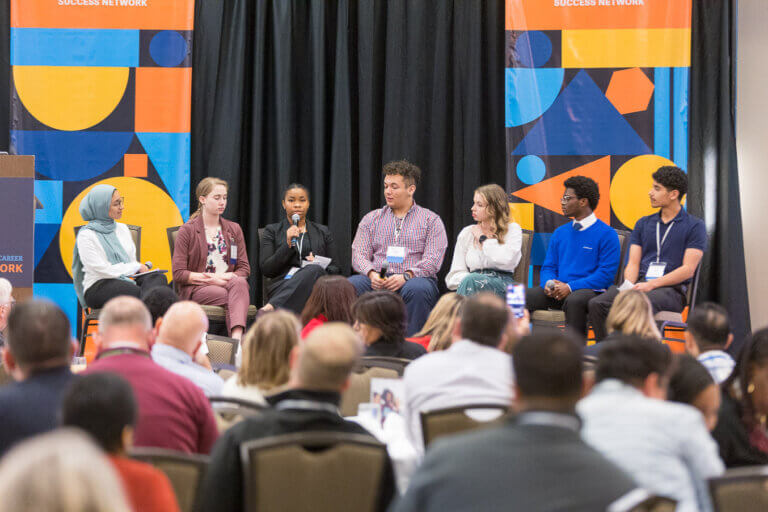Last week, the Illinois Report Card was updated to reflect the most recent data from the 2025 school year, shedding light on both areas of progress for Illinois students and areas requiring attention in policy and practice to enhance student access and outcomes. As affirmed in our Policy Agenda’s third pillar, Policy Evaluation & Continuous Improvement, we believe data like this can provide a valuable window into the health of our education system, particularly illuminating how students experience the system. This year’s release highlights notable progress in some high school indicators, but also identifies ongoing areas of concern in postsecondary transitions and success.
Post-Pandemic Recovery Continues
As we dive into the data, there are several areas for celebration in top-line measures:
9th Grade On-Track is up year-over-year and is demonstrating substantial recovery, both overall and in key demographic groups, from the significant dip due to the pandemic. Overall, 89.3 percent of 9th graders in school year 2025 were on track to graduate, up from 88.2 percent in school year 2024 and the pandemic-induced low of 82.2 percent in school year 2021. Gaps between disaggregated rates and the overall rates are also narrowing for many historically marginalized groups, including Black, Hispanic, low-income, and English language learners.
Chronic absenteeism rates continue to decline overall, down to 25.4 percent in school year 2025 from the high-water mark of 29.8 percent in school year 2022, though high rates persist for many students of color and low-income students. We celebrate this decline, but there is much work to do to improve rates for students from the most marginalized communities, where numbers are still too high. While these numbers are declining, rates were 39.3 percent for Black students, 31.7 percent for Hispanic students, and 35.1 percent for students from low-income households.
High school graduation has recovered to just above pre-pandemic levels, a 15-year high. In school year 2020, 88 percent of students graduated in four years, which dipped to 86.8 percent in school year 2021. In school year 2025, 89 percent of students graduated, which demonstrates a marked recovery from the early pandemic impacts.
Growth in Key College and Career Readiness Strategies
Dual credit enrollment continues to rise, including for students from marginalized communities, though gaps persist. Overall, dual credit enrollment grew 7.5 percent from school year 2024, and key student subgroups grew in participation as well. Black student overall dual credit enrollment rose 10 percent year-over-year from 2024, and Hispanic student participation grew 5.3 percent. Students from low-income families increased their enrollment in dual credit by 3.4 percent, and students with disabilities grew 3.8 percent. While dual credit enrollment rates continue to grow in the years since the pandemic, this growth has slowed for historically marginalized students, thus gaps persist between them and their peers. This means there is still more work to be done to increase access for students from marginalized communities, and we hope to see progress made as a result of the Dual Credit Quality Act amendment that was signed into law this past summer.
Career and Technical Education (CTE) is growing, including a nearly 10 percent increase in Concentrators. In addition to these overall numbers, growth is notable in a few key areas. Education CTE participants grew by nearly 20 percent, continuing an upward growth that extends to concentrators as well (up 12.6 percent year-over-year). Health science showed remarkable growth in concentrators (36.2 percent year-over-year) and 14.1 percent growth in participation as well. In manufacturing, participation and concentration have fluctuated in recent years since the high water mark of participants in school year 2023 (47,090) and concentrators in school year 2022 (25,498), but this year’s 35,803 participants are an 8.4 percent increase over school year 2024, and concentrators were up 12.2 percent year-over-year to a total of 12,784.
Postsecondary Transitions Remain an Area for Attention
Postsecondary enrollment fell year-over-year, from 66.1 percent for the class of 2022 to 64.9 percent for the class of 2023. Reflecting national trends, postsecondary enrollment continues to be an area for critical attention, as affordability remains a significant challenge and the value of college continues to be challenged. The Illinois Report Card indicates that more data may be forthcoming, but the currently reported postsecondary enrollment rates show a small increase in the proportion of students attending four-year institutions (41 percent, up from 40.6 percent), community college enrollment rate (23.9 percent, down from 25.5 percent year-over-year) appears to account for the decline in overall 12-month postsecondary enrollment.
Community college remediation in math increased year-over-year, while English rates show modest improvement. As with postsecondary enrollment, the Illinois Report Card indicates that these are preliminary data and may change with new information; however, 20.7 percent of the graduating class of 2023 took remedial math courses at community colleges in Illinois, up from 19 percent for the class of 2022. Fluctuations in remediation rates since 2020 prompt many questions, including the relationship between remediation rates and overall community college enrollment rates. Namely, are remediation rates higher because the overall proportion of Illinois high school graduates enrolled in community colleges has declined?
What Does This All Mean?
While we are excited to celebrate the continued recovery across key measures, such as high school graduation and participation in college and career readiness opportunities statewide, persistent challenges with chronic absenteeism, postsecondary enrollment, and postsecondary remediation signal an ongoing need to improve student engagement and retention during the transition between secondary and postsecondary education. As we continue to dive into these data, we will continue to reflect publicly on how strategies like work-based learning and career pathways models can drive student engagement and retention throughout the education system.


